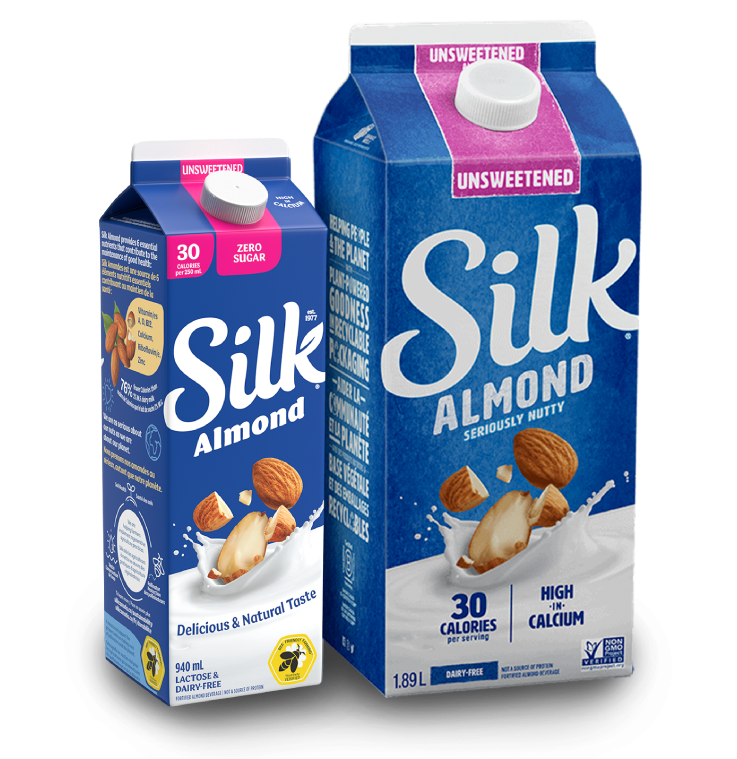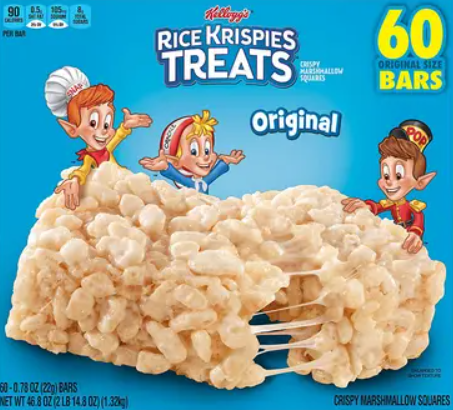Are Popcorners Gluten Free?
In today’s health-conscious world, more and more people are paying close attention to their dietary choices. Whether it’s due to celiac disease, gluten sensitivity, or simply a desire to reduce gluten intake, the question “Is it gluten-free?” has become increasingly common. One snack that often comes under scrutiny is Popcorners. In this comprehensive guide, we’ll dive deep into the world of Popcorners, exploring their ingredients, manufacturing processes, and nutritional benefits to answer the burning question: Are Popcorners gluten free?
Table of Contents
- What Are Popcorners?
- Understanding Gluten and Gluten-Free Diets
- Ingredients in Popcorners
- Are Popcorners Gluten Free?
- Popcorners Flavors and Gluten Content
- Manufacturing Process and Cross-Contamination Risks
- Nutritional Benefits of Popcorners
- Comparison with Other Gluten-Free Snacks
- How to Read Labels for Gluten-Free Products
- Popcorners in a Gluten-Free Lifestyle
- Potential Risks for Celiac Patients
- Alternatives to Popcorners for Gluten-Free Snacking
- FAQs About Popcorners and Gluten
- Conclusion
What Are Popcorners?
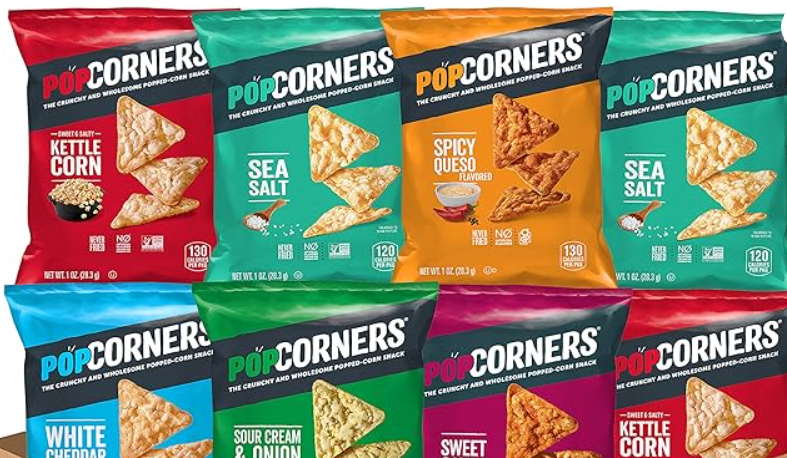
Popcorners are a popular snack food that has gained significant attention in recent years. Often described as a cross between popcorn and tortilla chips, these unique snacks offer a satisfying crunch with a variety of flavors. But what exactly are Popcorners?
Popcorners are made from corn, specifically popcorn kernels, that are heated and pressurized until they pop and form a chip-like shape. This innovative process results in a light, airy texture that’s different from traditional corn chips or popcorn. The snacks are then seasoned with various flavors, offering options to suit different taste preferences.
Key features of Popcorners include:
- Triangular shape reminiscent of tortilla chips
- Light and crispy texture
- Available in multiple flavors
- Often marketed as a healthier alternative to traditional chips
The brand has positioned itself as a better-for-you snack option, appealing to health-conscious consumers looking for tasty alternatives to conventional snack foods. But the question remains: do Popcorners fit into a gluten-free diet? To answer this, we first need to understand what gluten is and why it matters to so many people.
Understanding Gluten and Gluten-Free Diets
Before we delve into whether Popcorners are gluten-free, it’s crucial to understand what gluten is and why some people need to avoid it.
What is Gluten?
Gluten is a protein found in wheat, barley, rye, and some other grains. It acts as a binding agent, giving dough its elastic texture and helping it rise during baking. While gluten is harmless for most people, it can cause serious health issues for others.
Who Needs to Avoid Gluten?
Several groups of people need to avoid gluten:
- Celiac Disease Patients: Celiac disease is an autoimmune disorder where ingesting gluten leads to damage in the small intestine. For these individuals, even tiny amounts of gluten can cause severe symptoms and long-term health problems.
- Non-Celiac Gluten Sensitivity (NCGS): Some people experience symptoms similar to celiac disease when consuming gluten, but without the intestinal damage. This condition is known as non-celiac gluten sensitivity.
- Wheat Allergy Sufferers: While not all wheat allergy sufferers need to avoid all gluten-containing grains, many find it easier to follow a gluten-free diet.
- Personal Choice: Some people choose to reduce or eliminate gluten from their diet for perceived health benefits, even without a medical necessity.
The Importance of Gluten-Free Products
For those who need to avoid gluten, having access to a wide variety of gluten-free products is crucial. This includes not just obvious sources of gluten like bread and pasta, but also snack foods and other processed items where gluten might be present as an additive or due to cross-contamination.
This is why the question “Are Popcorners gluten free?” is so important for many consumers. Let’s move on to examine the ingredients in Popcorners to help answer this question.
Ingredients in Popcorners
To determine whether Popcorners are gluten-free, we need to take a close look at their ingredients. While the exact ingredient list can vary slightly depending on the flavor, the base ingredients for most Popcorners varieties are:
- Corn
- Vegetable Oil (typically Sunflower, Corn, or Canola Oil)
- Salt
Additional ingredients are added depending on the flavor, which may include:
- Sugar
- Natural and Artificial Flavors
- Spices
- Cheese (in cheese flavors)
- Buttermilk (in some flavors)
- Various seasonings
It’s important to note that the main ingredient, corn, is naturally gluten-free. This is a good starting point for those looking for gluten-free snack options. However, to definitively answer whether Popcorners are gluten-free, we need to consider a few more factors.
Are Popcorners Gluten Free?
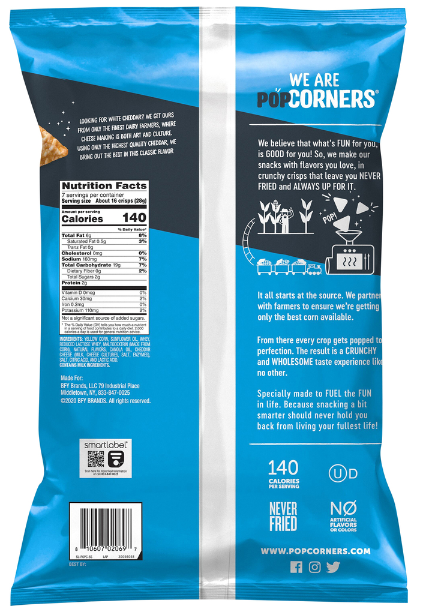
Now, let’s address the main question: Are Popcorners gluten free?
The short answer is: Yes, Popcorners are generally considered gluten-free.
Here’s why:
- Base Ingredients: As mentioned earlier, the primary ingredients in Popcorners (corn, oil, and salt) are naturally gluten-free.
- Company Claims: The manufacturer of Popcorners, BFY Brands (now owned by PepsiCo), states that their products are gluten-free.
- Gluten-Free Certification: Many Popcorners products carry a gluten-free certification, which means they have been tested and verified to contain less than 20 parts per million (ppm) of gluten, the standard set by the FDA for gluten-free labeling.
However, it’s important to note a few caveats:
- Flavor Variations: While the base product is gluten-free, some flavors might contain additional ingredients. Always check the label of the specific flavor you’re interested in.
- Cross-Contamination: Even though Popcorners are made from gluten-free ingredients, there’s always a small risk of cross-contamination during manufacturing if the facility also processes gluten-containing products.
- Individual Sensitivity: Some people with extreme gluten sensitivity might react to even trace amounts of gluten that fall below the 20 ppm threshold.
Given these factors, while Popcorners are generally considered safe for most people following a gluten-free diet, those with severe celiac disease or extreme gluten sensitivity should exercise caution and potentially consult with their healthcare provider.
Popcorners Flavors and Gluten Content
Popcorners come in a variety of flavors, each with its own unique blend of seasonings. Let’s take a closer look at some popular Popcorners flavors and their gluten status:
- Sea Salt: The simplest flavor, containing just corn, oil, and salt. This flavor is gluten-free.
- White Cheddar: Despite containing cheese, this flavor is typically gluten-free. However, always check the label to be sure.
- Kettle Corn: This sweet and salty flavor is generally gluten-free, but it’s essential to verify on the packaging.
- Sweet Chili: This spicy-sweet flavor is usually gluten-free, but as with all flavors, it’s best to double-check the label.
- Spicy Queso: While cheese-flavored snacks sometimes contain gluten, this flavor of Popcorners is typically gluten-free.
- Caramel: This sweet flavor is generally gluten-free, but always verify on the package.
- BBQ: BBQ-flavored snacks can sometimes contain gluten, but Popcorners BBQ flavor is usually gluten-free.
It’s important to note that while these flavors are typically gluten-free, manufacturers can change their recipes or production processes at any time. Therefore, it’s always a good practice to check the label each time you purchase, even if you’ve bought the same flavor before.
Additionally, be aware that Popcorners may introduce new flavors or limited-edition varieties from time to time. Always scrutinize the ingredient list and look for gluten-free labeling on these new products.
Manufacturing Process and Cross-Contamination Risks
Understanding the manufacturing process of Popcorners can provide further insight into their gluten-free status and potential risks for those with gluten sensitivities.
The Popcorners Production Process
- Corn Selection: The process begins with selecting high-quality popcorn kernels.
- Popping: The kernels are heated and pressurized in a specialized machine, causing them to pop and form their unique triangular shape.
- Seasoning: After popping, the Popcorners are seasoned with various flavors depending on the variety being produced.
- Packaging: The finished product is then packaged for distribution.
Cross-Contamination Concerns
While the ingredients used in Popcorners are gluten-free, cross-contamination during manufacturing is always a potential concern for those with celiac disease or severe gluten sensitivity. Cross-contamination can occur if gluten-containing products are processed on the same equipment or in the same facility.
To address these concerns, many food manufacturers, including the makers of Popcorners, take several precautions:
- Dedicated Equipment: Some companies use dedicated gluten-free production lines to minimize the risk of cross-contamination.
- Thorough Cleaning: Equipment is typically cleaned thoroughly between production runs, especially when switching between products containing allergens and those that don’t.
- Testing: Regular testing of products for gluten content helps ensure that cross-contamination hasn’t occurred.
- Certification: Many Popcorners products carry a gluten-free certification, indicating that they meet strict standards for gluten content.
Despite these precautions, individuals with extreme sensitivity to gluten should always exercise caution. If you have celiac disease or are highly sensitive to gluten, it may be worth contacting the manufacturer directly for more detailed information about their production processes and testing protocols.
Nutritional Benefits of Popcorners

While the gluten-free status of Popcorners is a crucial consideration for many, it’s also worth examining the overall nutritional profile of this popular snack. Popcorners are often marketed as a healthier alternative to traditional chips, but what does the nutritional breakdown actually look like?
Calories and Macronutrients
The exact nutritional content can vary slightly between flavors, but here’s a general overview based on a typical 1-ounce (28g) serving:
- Calories: Around 120-140 calories per serving
- Fat: 5-7 grams
- Carbohydrates: 18-20 grams
- Fiber: 1-2 grams
- Protein: 1-2 grams
Positive Nutritional Aspects
- Lower in Calories: Compared to many traditional chip options, Popcorners are relatively low in calories, making them a good option for those watching their calorie intake.
- Whole Grain: Popcorners are made from whole grain corn, which provides more nutrients than refined grains.
- Lower in Fat: Many varieties of Popcorners contain less fat than traditional fried potato chips.
- No Artificial Preservatives: Popcorners are typically made without artificial preservatives, appealing to those looking for more natural snack options.
Considerations
- Sodium Content: Some flavors of Popcorners can be high in sodium, which is something to be mindful of if you’re watching your salt intake.
- Added Sugars: Certain flavors, particularly sweet varieties like Kettle Corn, may contain added sugars.
- Fiber Content: While Popcorners do contain some fiber, the amount is relatively low compared to some other whole grain snacks.
Gluten-Free Nutritional Benefits
For those following a gluten-free diet, Popcorners can be a valuable addition to their snack repertoire:
- Variety: Popcorners offer a range of flavors, adding variety to gluten-free diets which can sometimes feel limited.
- Convenience: As a ready-to-eat snack, Popcorners provide a convenient gluten-free option for on-the-go snacking.
- Whole Grain: Many gluten-free products are made with refined flours, so a whole grain option like Popcorners can help boost whole grain intake for those on a gluten-free diet.
Remember, while Popcorners can be part of a balanced diet, they should be enjoyed in moderation as part of an overall healthy eating plan.
Comparison with Other Gluten-Free Snacks
To put Popcorners in context, let’s compare them with other popular gluten-free snack options:
- Rice Cakes:
- Pros: Very low in calories, versatile base for toppings
- Cons: Often bland on their own, can be less satisfying than Popcorners
- Potato Chips (Gluten-Free Varieties):
- Pros: Widely available, familiar taste
- Cons: Often higher in fat and calories than Popcorners
- Nuts:
- Pros: High in protein and healthy fats, nutrient-dense
- Cons: Higher in calories, may not satisfy cravings for crunchy, savory snacks
- Popcorn:
- Pros: Whole grain, high in fiber, low in calories if air-popped
- Cons: Can be messy, may not have the same variety of flavors as Popcorners
- Gluten-Free Pretzels:
- Pros: Crunchy, familiar snack food
- Cons: Often made with refined flours, may be higher in sodium
- Veggie Chips:
- Pros: Made from vegetables, can be nutrient-rich
- Cons: Can be high in fat and sodium, despite the “veggie” label
Compared to these options, Popcorners often strike a balance between nutritional value and snack satisfaction. They offer the crunch and flavor variety that many snackers crave, while generally being lower in calories and fat than traditional chips.
How to Read Labels for Gluten-Free Products
When shopping for gluten-free products like Popcorners, knowing how to read and interpret food labels is crucial. Here are some tips:
- Look for “Gluten-Free” Labeling: Many products, including some Popcorners varieties, will clearly state “Gluten-Free” on the packaging.
- Check for Certification Symbols: Look for symbols from organizations like the Gluten-Free Certification Organization (GFCO) or the Celiac Support Association (CSA).
- Read the Ingredient List: Even if a product isn’t labeled gluten-free, you can check the ingredients. Look out for:
- Wheat
- Barley
- Rye
- Malt
- Brewer’s yeast
- Oats (unless specified as gluten-free)
- Be Aware of Hidden Sources: Some ingredients may contain gluten without being obvious. These can include:
- Modified food starch (if not specified as corn)
- Dextrin
- Artificial and natural flavors (rarely, but possibly)
- Check for Allergen Statements: Many products will have a statement like “Contains: Wheat” or “May contain traces of wheat” near the ingredient list.
- Contact the Manufacturer: If you’re unsure about a product, don’t hesitate to reach out to the company directly for more information.
Remember, while Popcorners are generally gluten-free, it’s always a good practice to check the label each time you purchase, as formulations can change.
Popcorners in a Gluten-Free Lifestyle
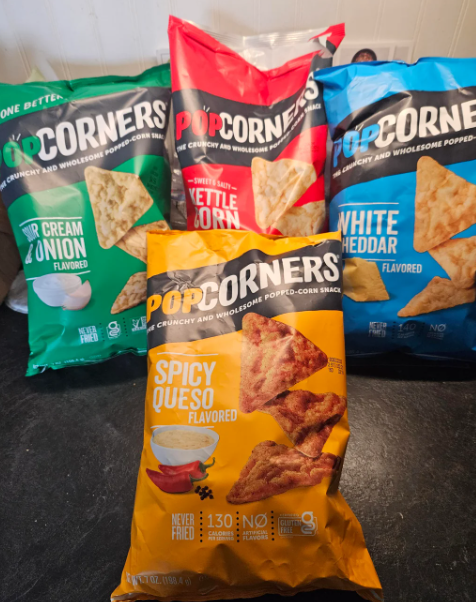
Incorporating Popcorners into a gluten-free lifestyle can be a great way to add variety and enjoyment to your snacking routine. Here are some ways to make the most of Popcorners while maintaining a gluten-free diet:
- On-the-Go Snacking: Popcorners come in convenient individual-sized bags, making them perfect for gluten-free snacking when you’re out and about.
- Party Snacks: Serve Popcorners at gatherings as a gluten-free alternative to chips and crackers. They pair well with dips and spreads.
- Lunchbox Addition: Add a small bag of Popcorners to your lunchbox or your child’s for a crunchy, gluten-free treat.
- Movie Night: Enjoy Popcorners as a less messy alternative to traditional popcorn during movie nights.
- Crumb Coating: Crush Popcorners and use them as a gluten-free coating for baked chicken or fish.
- Salad Topper: Crumble Popcorners over salads for a gluten-free crouton alternative.
- Trail Mix: Mix Popcorners with nuts, seeds, and dried fruits for a homemade gluten-free trail mix.
Remember, while Popcorners can be a fun and tasty part of a gluten-free diet, it’s important to maintain a balanced diet with a variety of foods.
Potential Risks for Celiac Patients
While Popcorners are generally considered gluten-free and safe for most people with celiac disease or gluten sensitivity, there are some potential risks to be aware of:
- Cross-Contamination: Even though Popcorners are made with gluten-free ingredients, there’s always a small risk of cross-contamination during manufacturing.
- Individual Sensitivity: Some people with celiac disease are extremely sensitive and may react to even trace amounts of gluten below the 20 ppm threshold set by the FDA for gluten-free labeling.
- Flavor Variations: While the base ingredients are gluten-free, some flavors might contain additional ingredients that could potentially contain gluten.
- Shared Equipment: If Popcorners are produced on equipment that also processes gluten-containing products, there’s a risk of cross-contact.
- Changes in Manufacturing: Companies may change their manufacturing processes or ingredient sources over time, which could potentially impact the gluten-free status of the product.
For individuals with celiac disease, especially those who are highly sensitive, it’s advisable to:
- Always check the label, even if you’ve purchased the product before
- Look for gluten-free certification when possible
- Consider contacting the manufacturer for more detailed information about their gluten-free practices
- Introduce new products gradually and monitor for any reactions
If you experience any symptoms after consuming Popcorners or any other supposedly gluten-free product, discontinue use and consult with your healthcare provider.
Alternatives to Popcorners for Gluten-Free Snacking
While Popcorners are a popular gluten-free snack option, variety is key in any diet. Here are some other gluten-free snack alternatives you might consider:
- Air-popped Popcorn: A classic, whole-grain snack that’s naturally gluten-free. Season it yourself for control over ingredients.
- Rice Cakes: Available in various flavors, rice cakes are a light, crunchy gluten-free option.
- Nuts and Seeds: Packed with protein and healthy fats, nuts and seeds make for a nutritious gluten-free snack.
- Fresh Fruits and Vegetables: Nature’s perfect snack, always gluten-free and packed with nutrients.
- Gluten-Free Pretzels: Many brands now offer gluten-free versions of this popular snack.
- Corn Tortilla Chips: Made from corn, these are usually gluten-free, but always check the label.
- Roasted Chickpeas: A crunchy, high-protein gluten-free snack that you can make at home or buy pre-packaged.
- Gluten-Free Crackers: Made from alternative flours like rice, almond, or coconut.
- Cheese: Most types of cheese are naturally gluten-free and provide protein and calcium.
- Gluten-Free Granola: Look for varieties made with gluten-free oats and other gluten-free ingredients.
Remember, while these alternatives are generally gluten-free, it’s always important to check labels and be aware of potential cross-contamination, especially if you have celiac disease or severe gluten sensitivity.
FAQs About Popcorners and Gluten
Here are some frequently asked questions about Popcorners and their gluten-free status:
- Q: Are all flavors of Popcorners gluten-free? A: While most flavors of Popcorners are gluten-free, it’s always best to check the label of each specific flavor, as ingredients can vary.
- Q: Is there a risk of cross-contamination with gluten in Popcorners? A: While Popcorners are made with gluten-free ingredients, there’s always a small risk of cross-contamination during manufacturing. The company takes precautions to prevent this, but individuals with severe gluten sensitivity should exercise caution.
- Q: Are Popcorners certified gluten-free? A: Many Popcorners products carry a gluten-free certification. Look for this on the packaging or check the company’s website for the most up-to-date information.
- Q: Can people with celiac disease eat Popcorners? A: Most people with celiac disease can safely consume Popcorners. However, individuals with extreme sensitivity should consult with their healthcare provider and possibly contact the manufacturer for more detailed information.
More FAQs About Popcorners and Gluten
- Q: Do Popcorners contain any wheat products? A: No, Popcorners are corn-based and do not contain wheat. However, always check the label to be sure, especially with new or limited-edition flavors.
- Q: How many parts per million (ppm) of gluten are in Popcorners? A: For products labeled gluten-free, the FDA requires that they contain less than 20 ppm of gluten. For specific information about Popcorners, you may need to contact the manufacturer.
- Q: Can I use Popcorners as a substitute for bread crumbs in gluten-free recipes? A: Yes, crushed Popcorners can be used as a gluten-free alternative to bread crumbs in many recipes.
- Q: Are Popcorners healthier than regular potato chips? A: Popcorners are often lower in fat and calories than traditional potato chips, but nutritional content can vary by flavor. They’re made from whole grain corn, which may offer some nutritional benefits.
- Q: Can I eat Popcorners if I have a corn allergy? A: No, Popcorners are made primarily from corn and are not suitable for individuals with corn allergies.
- Q: Where can I find the full ingredient list for Popcorners? A: The full ingredient list can be found on the packaging of each product. You can also usually find this information on the company’s website or by contacting them directly.
Conclusion
In conclusion, Popcorners are generally considered to be gluten-free and can be a suitable snack option for most people following a gluten-free diet. The main ingredients – corn, oil, and salt – are naturally gluten-free, and many Popcorners products carry gluten-free certification.
However, as with any processed food, there are some considerations to keep in mind:
- Always check the label, as ingredients and manufacturing processes can change.
- Be aware of the potential for cross-contamination, especially if you have severe gluten sensitivity or celiac disease.
- Remember that while Popcorners can be part of a balanced diet, they should be enjoyed in moderation alongside a variety of other nutritious foods.
For most people seeking gluten-free snack options, Popcorners offer a tasty, convenient choice that comes in a variety of flavors. They provide a satisfying crunch without the gluten, making them a popular alternative to traditional chips and crackers.
As the gluten-free market continues to grow, it’s encouraging to see products like Popcorners that cater to dietary restrictions without compromising on taste or texture. However, it’s always important to make informed decisions about your diet based on your individual health needs and preferences.
Whether you’re living with celiac disease, have a gluten sensitivity, or are simply choosing to reduce your gluten intake, remember that a balanced, varied diet is key to overall health. Popcorners can certainly have a place in such a diet, offering a gluten-free way to satisfy those snack cravings.
As always, if you have specific concerns about introducing any new food into your diet, it’s best to consult with a healthcare professional or registered dietitian. They can provide personalized advice based on your individual health status and dietary needs.

